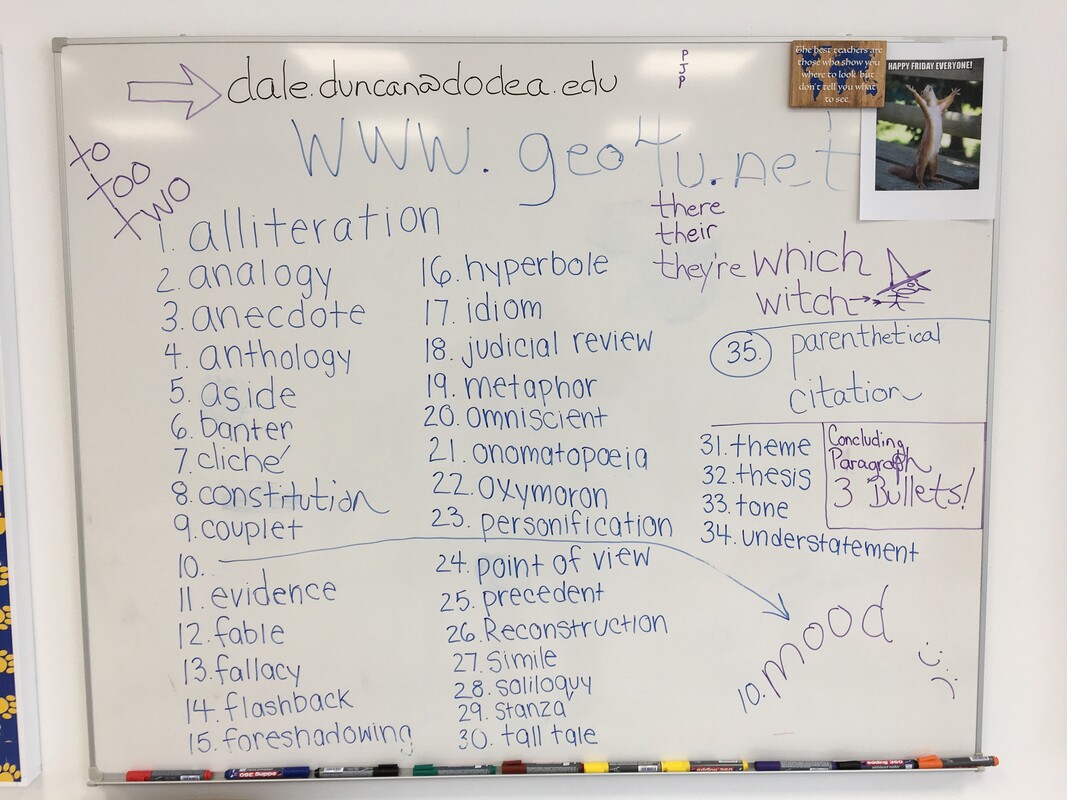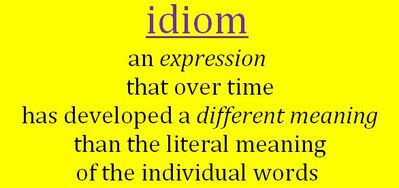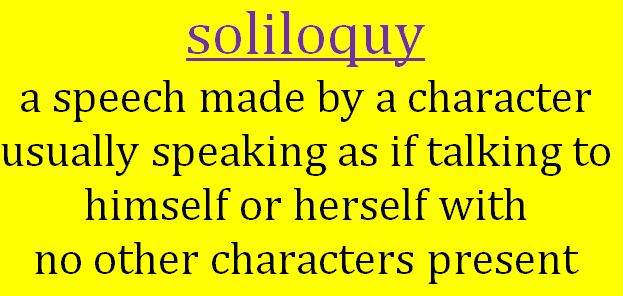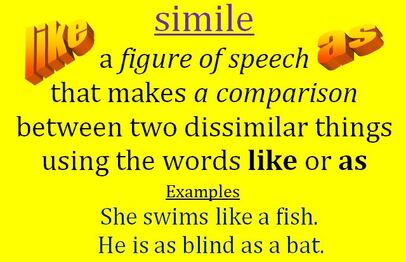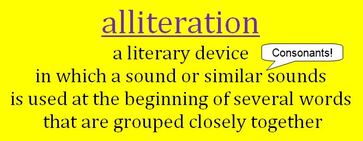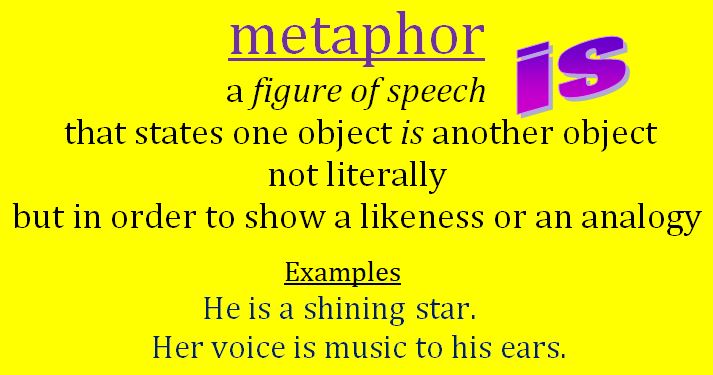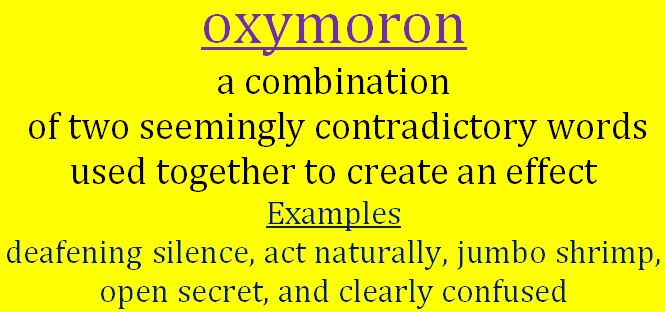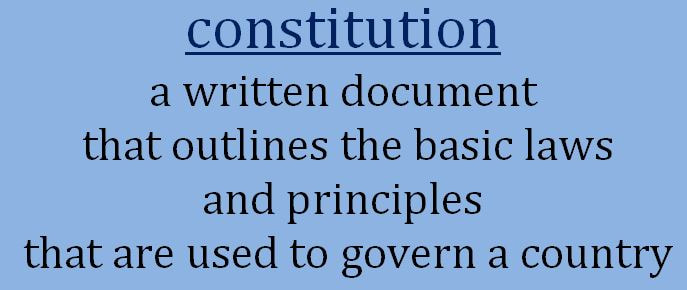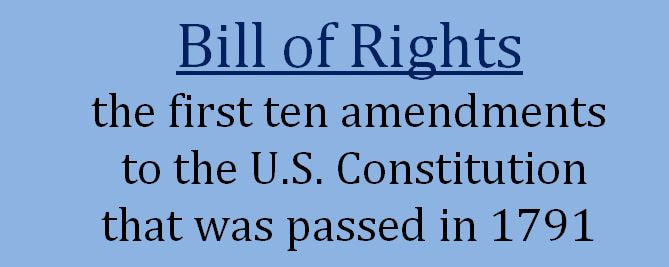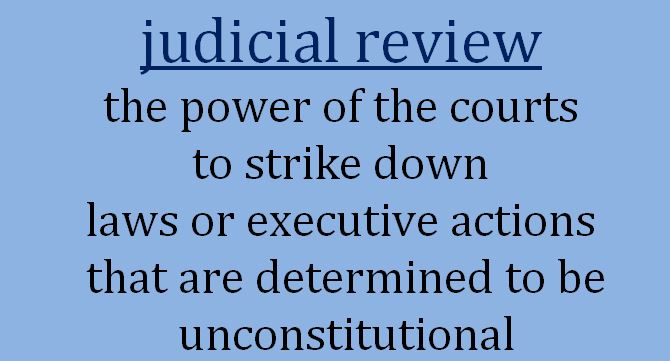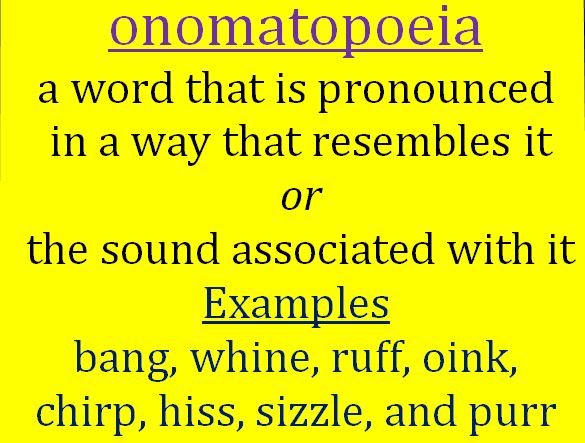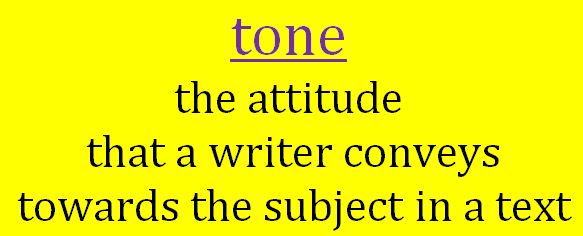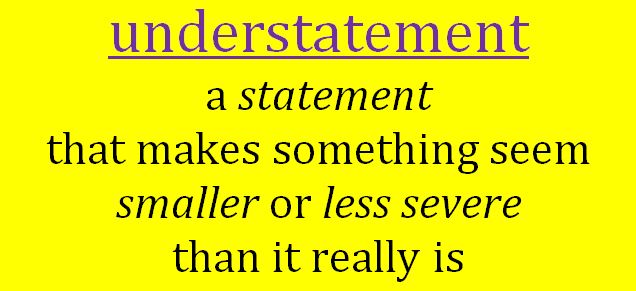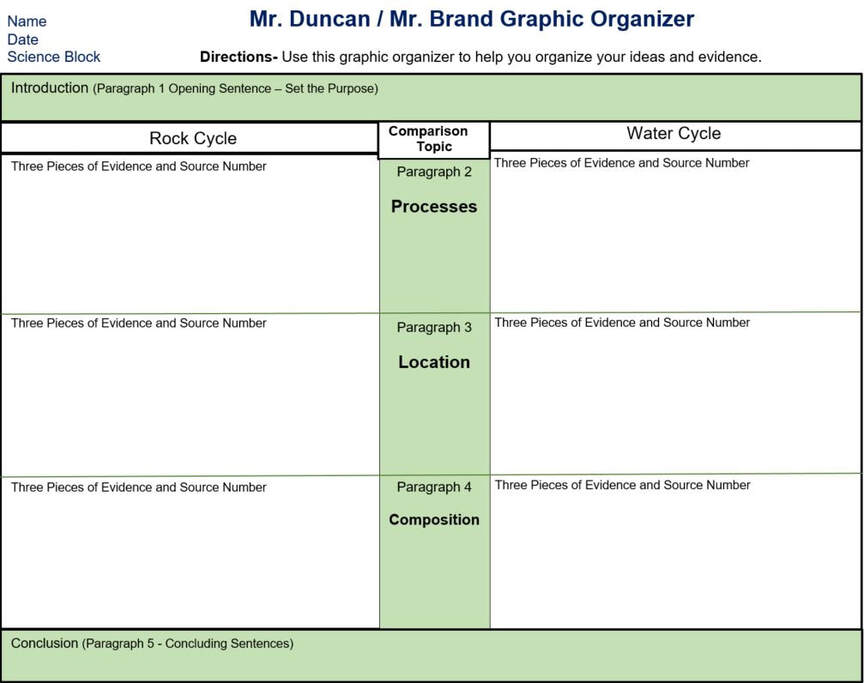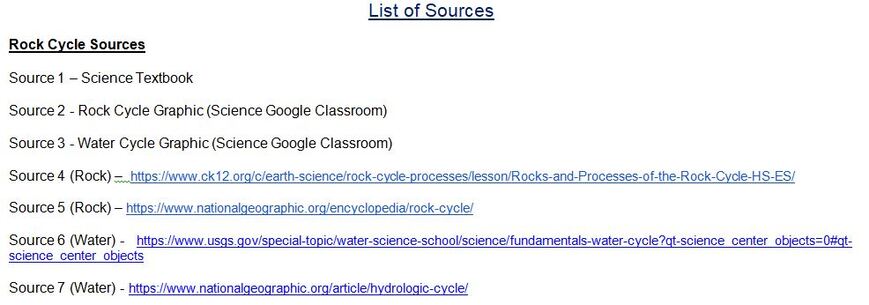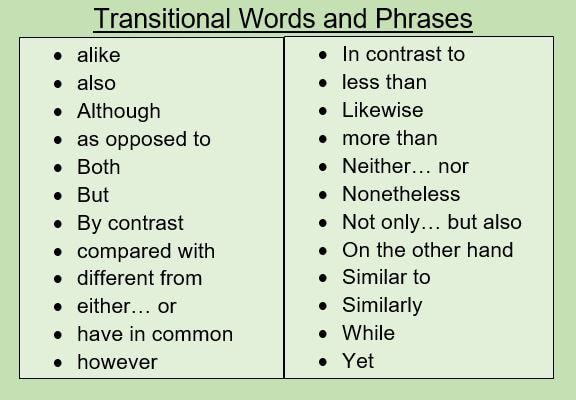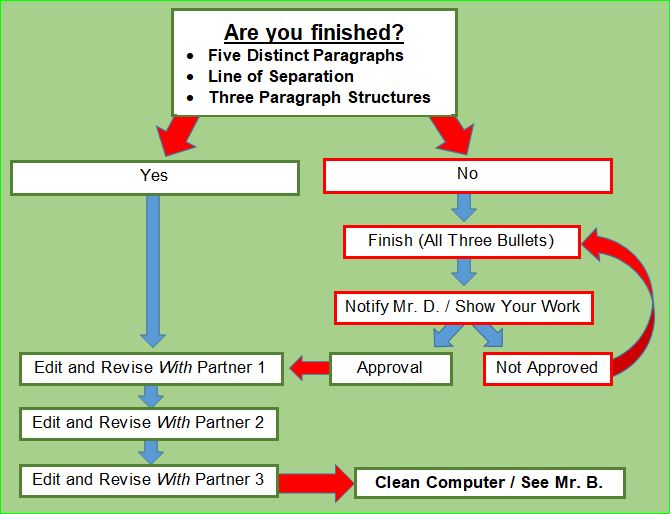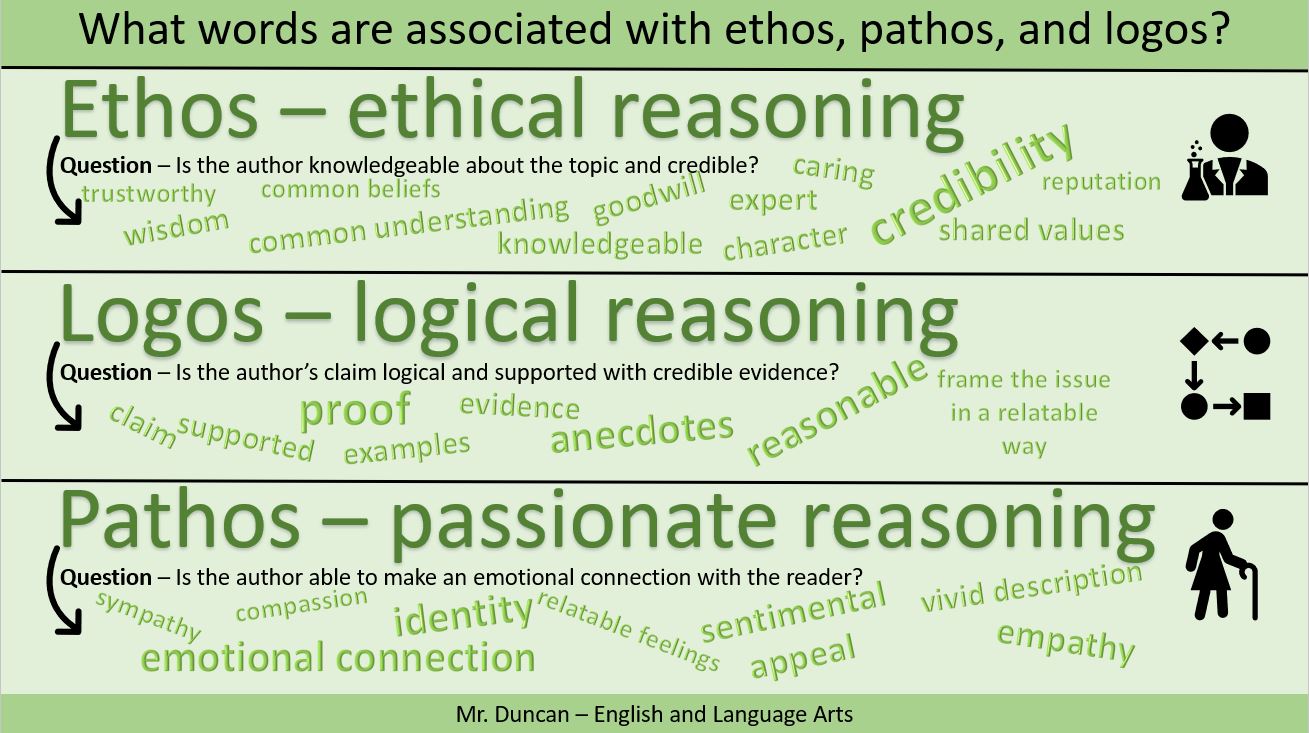Extra Credit Words - Reconstruction, intrepid, and abolitionist
Be intrepid and learn the definitions of all three words (words that you know will be on the test).
|
analogy a comparison of two different things that have some aspect in common Examples The moon is to night as the sun is to day. A puppy is to dog as a fawn is to deer. “Life is like a box of chocolates—you never know what you're gonna get.” Examples of clichés
|
aside a character’s speech in a play made directly to an audience but not heard by other characters Examples of Tall Tales
|
fable
(noun) a short fictional story, that often uses animals as characters,
to teach a moral lesson
(noun) a short fictional story, that often uses animals as characters,
to teach a moral lesson
Examples
- The Wolf in Sheep's Clothing
- Tortoise and the Hare
- The Wolf in Sheep's Clothing
- Tortoise and the Hare
|
There, They're, and Their there - refers to a location they're - a contraction of "they are" their - a possessive pronoun (shows possession) |
Two, To, and Too two - refers to a number to - a preposition that refers to a direction too - an adverb that means also or excessively |
Witch or Which witch - refers to a person which - is used as part of a question |
ELA Lesson 20 - Close Reading
DoDEA Standard
RI.7.1: Cite several pieces of textual evidence to support analysis of what the text says explicitly as well as
inferences drawn from the text.
RI.7.2: Determine a theme or central idea of a text and analyze its development over the course of the text; provide
an objective summary of the text.
RI.7.4: Determine the meaning of words and phrases as they are used in a text, including figurative, connotative,
and technical meanings; analyze the impact of a specific word choice on meaning and tone.
RI.7.1: Cite several pieces of textual evidence to support analysis of what the text says explicitly as well as
inferences drawn from the text.
RI.7.2: Determine a theme or central idea of a text and analyze its development over the course of the text; provide
an objective summary of the text.
RI.7.4: Determine the meaning of words and phrases as they are used in a text, including figurative, connotative,
and technical meanings; analyze the impact of a specific word choice on meaning and tone.
ELA Lesson 20 Part 1 - Review of Close Reader Requirements and Assignment
ELA Lesson 20 Part 1 Assignment - "Difference Maker: John Bergman and Popcorn Park"
Keep in mind the Close Reader requirements as you complete this assignment. This article begins on page 107 and ends on page 112. When you have completed this assignment, take pictures of it and then download the pictures (in order) in Google Classroom. This assignment is due at 2:35 today.
Homework- Vocabulary Sets #4 and #5 Reassigned
- Read the author "Background" before reading the story.
- Complete the writing / annotating portions of the assignments as directed; these are numbered and refer to specific parts of the texts.
- Use bold print, a text feature, to help you identify difficult vocabulary words.
- Cite evidence using quotes and referencing specific line numbers.
- Use the www.geo4u.net online glossary to define the words that are shown in the margin.
- Recall that the line numbers are shown starting on the second page.
- Note the “Close Read Notes” to the side and the space below it for your work.
- Restate the written responses when you are asked questions.
- Work with your group to discuss the “small group” portion of the assignment.
- Complete the “Short Response” at the end of the stories using evidence from the text. A satisfactory response requires that you cite evidence as part of your answer. This usually requires at least four full sentences to answer.
ELA Lesson 20 Part 1 Assignment - "Difference Maker: John Bergman and Popcorn Park"
Keep in mind the Close Reader requirements as you complete this assignment. This article begins on page 107 and ends on page 112. When you have completed this assignment, take pictures of it and then download the pictures (in order) in Google Classroom. This assignment is due at 2:35 today.
Homework- Vocabulary Sets #4 and #5 Reassigned
ELA Lesson 21 - Close Reading
DoDEA Standard
RL.7.1: Cite several pieces of textual evidence to support analysis of what the text says explicitly as well as inferences drawn from the text.
RL.7.4: Determine the meaning of words and phrases as they are used in a text, including figurative, connotative, and technical meanings; analyze the impact of a specific word choice on meaning and tone.
RL.7.7: Compare and contrast a written story, drama, or poem to its audio, filmed, staged, or multimedia version, analyzing the effects of techniques unique to each medium (e.g., lighting, sound, color, or camera focus and angles in a film).
W7.2 Write informative/explanatory texts to examine a topic and convey ideas, concepts, and information through the selection, organization, and analysis of relevant content.
RL.7.1: Cite several pieces of textual evidence to support analysis of what the text says explicitly as well as inferences drawn from the text.
RL.7.4: Determine the meaning of words and phrases as they are used in a text, including figurative, connotative, and technical meanings; analyze the impact of a specific word choice on meaning and tone.
RL.7.7: Compare and contrast a written story, drama, or poem to its audio, filmed, staged, or multimedia version, analyzing the effects of techniques unique to each medium (e.g., lighting, sound, color, or camera focus and angles in a film).
W7.2 Write informative/explanatory texts to examine a topic and convey ideas, concepts, and information through the selection, organization, and analysis of relevant content.
ELA Lesson 21 Part 1 - He-y, Come On Ou-t! by Shinichi Hoshi
Your Close Reader assignments from last week have been graded and posted. Please look at the note next to the grade in GradeSpeed to see how you might improve.
Major Areas For Improvement
Review the Close Reader requirements as you complete this assignment. This article begins on page 87 and ends on page 92. When you have completed this assignment, take pictures of it and then download the pictures (in order) in Google Classroom. This assignment is due at 2:35 today.
ELA Lesson 21 Part 2 - He-y, Come On Ou-t! by Shinichi Hoshi Discussion
Have your Close Reader handy so that you can actively participate in the discussion.
Your Close Reader assignments from last week have been graded and posted. Please look at the note next to the grade in GradeSpeed to see how you might improve.
Major Areas For Improvement
- Remember that you are expected to use evidence in your answers and provide line numbers where you found the evidence.
- Remember that the "Short Response" requires a complete answer with evidence; it is also the most important part of the assignment.
- Remember to check your pictures to make sure that they are clear.
Review the Close Reader requirements as you complete this assignment. This article begins on page 87 and ends on page 92. When you have completed this assignment, take pictures of it and then download the pictures (in order) in Google Classroom. This assignment is due at 2:35 today.
ELA Lesson 21 Part 2 - He-y, Come On Ou-t! by Shinichi Hoshi Discussion
Have your Close Reader handy so that you can actively participate in the discussion.
ELA Lesson 22 - Close Reading and Graphic Organizer
DoDEA Standard
RL.7.1: Cite several pieces of textual evidence to support analysis of what the text says explicitly as well as inferences drawn from the text.
RL.7.4: Determine the meaning of words and phrases as they are used in a text, including figurative, connotative, and technical meanings; analyze the impact of a specific word choice on meaning and tone.
RL.7.7: Compare and contrast a written story, drama, or poem to its audio, filmed, staged, or multimedia version, analyzing the effects of techniques unique to each medium (e.g., lighting, sound, color, or camera focus and angles in a film).
W7.2 Write informative/explanatory texts to examine a topic and convey ideas, concepts, and information through the selection, organization, and analysis of relevant content.
RL.7.1: Cite several pieces of textual evidence to support analysis of what the text says explicitly as well as inferences drawn from the text.
RL.7.4: Determine the meaning of words and phrases as they are used in a text, including figurative, connotative, and technical meanings; analyze the impact of a specific word choice on meaning and tone.
RL.7.7: Compare and contrast a written story, drama, or poem to its audio, filmed, staged, or multimedia version, analyzing the effects of techniques unique to each medium (e.g., lighting, sound, color, or camera focus and angles in a film).
W7.2 Write informative/explanatory texts to examine a topic and convey ideas, concepts, and information through the selection, organization, and analysis of relevant content.
ELA Lesson 22 Part 1 Article - "The North American Beaver"
During the Thursday ELA virtual lesson you will be asked to submit three sentences that answer the question shown in gold. Remember to provide evidence from the text in the form of a quote from the article. The expectation is that you will prepare your response in advance and be ready to paste it in the chat box at the beginning of the lesson. This is a graded assignment.
How does the beaver impact the environment?
ELA Lesson 22 Part 2 - Submit Your Prepared Chat Response / Understanding the Graphic Organizer
- "The North American Beaver" Discussion
- Understanding the Graphic Organizer
During the Thursday ELA virtual lesson you will be asked to submit three sentences that answer the question shown in gold. Remember to provide evidence from the text in the form of a quote from the article. The expectation is that you will prepare your response in advance and be ready to paste it in the chat box at the beginning of the lesson. This is a graded assignment.
How does the beaver impact the environment?
ELA Lesson 22 Part 2 - Submit Your Prepared Chat Response / Understanding the Graphic Organizer
- "The North American Beaver" Discussion
- Understanding the Graphic Organizer
Graphic Organizer Notes
- Write one sentence in the green "Introduction" box that shows the purpose of your essay.
- Use at least two different sources when you gather facts for each topic box.
- Use at least three different sources for each cycle (rock cycle and water cycle).
- Use entire quotes when you gather facts to support your topics.
- Write one sentence in the green "Conclusion" box that will be your final sentence in the paper and "wraps it up."
ELA Lesson 23 - Reading and Writing
ELA Lesson 23 Part 1 - The Buffalo Soldiers
February has been designated as Black History Month. It is a time when we can reflect on the accomplishments of African-Americans.
Today we will focus on a little known aspect of military history - the Buffalo Soldiers.
Class Assignment- Watch both of the short videos that are linked below. Then, write a paragraph that describes the Buffalo Soldiers and their place in history. Use specific statements that describe why men wanted to join these units and what they did during the late 1800s. Write at least nine well-written sentences that include evidence from these two videos only. Begin by creating a new Google Doc and typing the appropriate heading in the upper-left-hand corner (name, date, Mr. Duncan Block #). Type the paragraph and then submit it in Google Classroom. This assignment is due at 2:35 today.
Suggestion- Take notes as you watch the videos and be ready to pause it when necessary. This will allow your to organize your ideas and write (type) you assignment relatively quickly. If you do take notes, take a picture of the notes and submit it with your Google Doc (extra-credit).
February has been designated as Black History Month. It is a time when we can reflect on the accomplishments of African-Americans.
Today we will focus on a little known aspect of military history - the Buffalo Soldiers.
Class Assignment- Watch both of the short videos that are linked below. Then, write a paragraph that describes the Buffalo Soldiers and their place in history. Use specific statements that describe why men wanted to join these units and what they did during the late 1800s. Write at least nine well-written sentences that include evidence from these two videos only. Begin by creating a new Google Doc and typing the appropriate heading in the upper-left-hand corner (name, date, Mr. Duncan Block #). Type the paragraph and then submit it in Google Classroom. This assignment is due at 2:35 today.
Suggestion- Take notes as you watch the videos and be ready to pause it when necessary. This will allow your to organize your ideas and write (type) you assignment relatively quickly. If you do take notes, take a picture of the notes and submit it with your Google Doc (extra-credit).
|
|
|
|
ELA Lesson 23 Part 2 - Graphic Organizer Wrap-up / John Lewis
Prepare and submit this gold question prior to the beginning of class on Friday. Make sure you add a heading (name, date, Duncan - Block _" and the title of the assignment. Your response must answer the question shown in gold below and use evidence from the text. Use one quote and at least two other sentences that are written in your own words. This is a graded assignment. In what way did the late John Lewis impact American history? |
ELA Lesson 23 Part 3- Submit Prepared Chat Response / Speech from the Democratic National Convention
- Choose one person in the group to read aloud the "Speech from the Democratic National Convention" Speech by John Lewis.
- Discuss question eight from the Close Reader with your group.
- Write your response to question eight under the "Close Read Notes" section on page 102.
- Your response must include four sentences, one of which must be a quote, and the line numbers of the quote.
- Do not complete the "Short Response" today.
- Download the picture in Google Classroom before 2:35 (before progress reports go out).
HW- from "The Most Daring of [Our] Leaders" by Lynne Olson Due- 7:59 AM on February 17th (Wednesday)
Follow the guidelines established in Lesson 20 to complete this Close Reader assignments (including the Short Response). Use complete sentences for all of your written responses and use evidence. Submit pictures of the completed assignment before the due date and time.
- Submit Prepared Response (late responses via email will not be accepted)
- Discussion and Context
- Break-out Room Assignment
- Choose one person in the group to read aloud the "Speech from the Democratic National Convention" Speech by John Lewis.
- Discuss question eight from the Close Reader with your group.
- Write your response to question eight under the "Close Read Notes" section on page 102.
- Your response must include four sentences, one of which must be a quote, and the line numbers of the quote.
- Do not complete the "Short Response" today.
- Download the picture in Google Classroom before 2:35 (before progress reports go out).
HW- from "The Most Daring of [Our] Leaders" by Lynne Olson Due- 7:59 AM on February 17th (Wednesday)
Follow the guidelines established in Lesson 20 to complete this Close Reader assignments (including the Short Response). Use complete sentences for all of your written responses and use evidence. Submit pictures of the completed assignment before the due date and time.
ELA Lesson 24 - Focus on Writing
DoDEA Standard
W7.2 Write informative/explanatory texts to examine a topic and convey ideas, concepts, and information through the selection, organization, and analysis of relevant content.
W7.2 Write informative/explanatory texts to examine a topic and convey ideas, concepts, and information through the selection, organization, and analysis of relevant content.
DUE- from "The Most Daring of [Our] Leaders" by Lynne Olson Close Reader Assignment
ELA Lesson 24 Part 1- Writing the Introductory Paragraph
ELA Lesson 24 Part 1- Writing the Introductory Paragraph
- Introduce your pet! (live, in the US, pets who are no longer with us)
- Submit Prepared Response (late responses via email will not be accepted)
- Discussion and Context
- Direct Instruction (Have your graphic organizer ready. to use.)
Compare and Contrast Essay Overview of the Entire Structure
- Introduction (information shown below)
- Paragraph 2 - processes
- Paragraph 3 - location
- Paragraph 4 - composition
- Conclusion (the final part of the essay process)
Compare and Contrast Structure - Focus on the Introduction
- Introduce your topic
- Comparison topic one - processes (one sentence)
- Comparison topic two - location (one sentence)
- Comparison topic three - composition (one sentence)
- Final sentence to hook you audience and make them want to read it
ELA L24 Homework Assignment - Essay Introduction Paragraph
Use the information that was discussed in class and the information above to write the introduction to your essay. Complete the introduction using a Google Doc and title it "2021 2 17 Last Name L24 Part 1 Introduction." Obviously, you will submit your last name for the words "Last Name."
If you have questions or want feedback about your paragraph, please request an appointment.
Complete and submit your completed essay via Google Classroom by 7:59 AM Friday.
--------------------------------------------------------------------------------------------------------------------------------------------------------------------------
ELA Lesson 25 - Focus on Writing
DoDEA Standard
W7.2 Write informative/explanatory texts to examine a topic and convey ideas, concepts, and information through the selection, organization, and analysis of relevant content.
W7.2 Write informative/explanatory texts to examine a topic and convey ideas, concepts, and information through the selection, organization, and analysis of relevant content.
ELA Lesson 25 Part 1 - Welcome Back and Overview of the Next Two Weeks
Vocabulary Set 6 (Assigned)
Cut and glue each of the words onto a notecard. Use the online class glossary to write the correct definition for each word on the back of the card (the definition should take-up most of each card). Use a highlighter to outline the edges of the following words: Federalism, Antifederalist, and capitol. Submit one clear picture of the front and one clear picture of the back of the card set. (Due March 1st 7:59 AM) Remember that you are required to bring all of your notecards to class daily.
ELA Lesson 25 Part 2 - How to Write the Body of the Essay
- vocabulary cards
- oxymoron (definition and four examples)
Vocabulary Set 6 (Assigned)
Cut and glue each of the words onto a notecard. Use the online class glossary to write the correct definition for each word on the back of the card (the definition should take-up most of each card). Use a highlighter to outline the edges of the following words: Federalism, Antifederalist, and capitol. Submit one clear picture of the front and one clear picture of the back of the card set. (Due March 1st 7:59 AM) Remember that you are required to bring all of your notecards to class daily.
ELA Lesson 25 Part 2 - How to Write the Body of the Essay
- Paragraph 2 - processes
- Paragraph 3 - location
- Paragraph 4 - composition
Compare and Contrast Structure - The Three Essay Body Paragraphs
- Introduce and define your topic (explain what the topic is and what it means from a science perspective)
- Describe how the topic is related to the rock cycle
- Describe how the topic is related to the water cycle
- Compare and contrast the two cycles (similar or different)
Word Document Title - "2021 2 23 Last Name Compare and Contrast Essay"
Word Document Title - "2021 2 23 Last Name Compare and Contrast Essay"
ELA Lesson 25 Part 3 - Suggestions for Improve Your Writing
Compare and Contrast Essay Feedback From Your Q1 C&C Essays
Compare and Contrast Essay Feedback From Your Q1 C&C Essays
- Indent the first sentence of every paragraph using the tab key.
- Use the format of the titles that are shown in the writing prompt.
- Avoid the use “I” and “we” in your sentences.
- Do not end paragraphs with quotations.
- Use italics when you are typing the title of a book.
- Do not begin sentences with the word “like.”
- When using quotation marks, place the period inside the concluding quotation mark at the end of a sentence.
- Do not use a capital letter in the quote when using only a portion of a quote in the middle or end of a sentence.
- Do not introduce new information or use quotes in the concluding paragraph.
- The concluding paragraph in an essay must be at least three sentences long.
ELA Lesson 25 Part 4 - Focus on Paragraph Four
Asynchronous Assignment - Finish the First Four Paragraphs and Break Them Down
Follow the guidance that was provided in class. Finish writing the first four paragraphs so that you can complete the conclusion on Monday. After you have completed the sentences make a line below the paragraphs. Copy the structure shown below and paste it three times at the bottom of the document. Next, make a copy of each paragraph and paste them below the each structure. Finally, cut and paste each paragraph and place it under the appropriate structure sections.
Paragraph Structure Check
Introduce and define your topic (explain what the topic is and what it means from a science perspective)
-
Describe how the topic is related to the rock cycle
-
Describe how the topic is related to the water cycle
-
Compare and contrast the two cycles (similar or different)
-
Homework - Update Planner
Use the links at https://www.geo4u.net/1820info.html to update your planner. Outline the "Social Studies" box, the "Language Arts" and "Reading" boxes. Write all of the information shown on the calendar pages, using bullet statements, in the appropriate boxes. 5 Points (Due March 1st 7:59 AM)
-----------------------------------------------------------------------------------------------------------------------------------------------------------------------------
- Paragraph Four
- Spelling and Grammar Check
- Copy and Paste to Goggle Doc
- Email an Attached Copy of the Word Doc to Mr. D.
Asynchronous Assignment - Finish the First Four Paragraphs and Break Them Down
Follow the guidance that was provided in class. Finish writing the first four paragraphs so that you can complete the conclusion on Monday. After you have completed the sentences make a line below the paragraphs. Copy the structure shown below and paste it three times at the bottom of the document. Next, make a copy of each paragraph and paste them below the each structure. Finally, cut and paste each paragraph and place it under the appropriate structure sections.
Paragraph Structure Check
Introduce and define your topic (explain what the topic is and what it means from a science perspective)
-
Describe how the topic is related to the rock cycle
-
Describe how the topic is related to the water cycle
-
Compare and contrast the two cycles (similar or different)
-
Homework - Update Planner
Use the links at https://www.geo4u.net/1820info.html to update your planner. Outline the "Social Studies" box, the "Language Arts" and "Reading" boxes. Write all of the information shown on the calendar pages, using bullet statements, in the appropriate boxes. 5 Points (Due March 1st 7:59 AM)
-----------------------------------------------------------------------------------------------------------------------------------------------------------------------------
ELA Lesson 26 - Focus on Writing
DoDEA Standard
W7.2 Write informative/explanatory texts to examine a topic and convey ideas, concepts, and information through the selection, organization, and analysis of relevant content.
W7.2 Write informative/explanatory texts to examine a topic and convey ideas, concepts, and information through the selection, organization, and analysis of relevant content.
ELA Lesson 26 Part 1 - Concluding Paragraph
By the beginning of this class you should have all four of the paragraphs and the three structures completed. Today you will complete the concluding paragraph and finish your entire rough draft.
Priorities For Today
By the beginning of this class you should have all four of the paragraphs and the three structures completed. Today you will complete the concluding paragraph and finish your entire rough draft.
Priorities For Today
- Copy and Paste Updated Essay from Google Docs (if you took it home and worked on your essay)
- Write the Concluding Paragraph
- Make sure you have a line and the three structures completed
- Complete the Spelling and Grammar Check
- Edit and Revise
ELA Lesson 26 Part 2 - Peer Edit and Feedback Day
Now that your essay is complete you will have an opportunity to peer edit your paper. It is critical that you make corrections and revisions as you discover errors.
By the end of the day your paper should be polished and ready to submit.
- Copy and paste your updated draft from Google Docs to your Microsoft Word document (if applicable).
- Add the word "8 AM Draft" the end of your document title.
- Everyone must email their draft by 8:15 to the correct DoDEA email address.
- Follow the flowchart to see what you do next.
Peer Edit Pairs
ELA Lesson 26 Part 3 - Finalize Changes and Submit the Assignment
Yesterday you had an opportunity to peer edit your paper and to make the necessary corrections. This morning you will complete the following steps and then submit your essay.
Final Instructions (Time on Task 15-20 Minutes)
- Copy and paste paragraphs two, three, and four below the appropriate structure.
- Cut and paste the essay parts under the appropriate section.
HW- Update Your Planner
- Only one of you will have a computer.
- The writer will read their paper aloud to their partner (the listener).
- Focus on one paragraph at a time.
- Fix errors as they are found.
- Reread the paragraph once it has been fixed to ensure that it flows.
- The listener should point-out errors in the content (the science information).
- The listener should make polite suggestions for improvement.
- Once finished, the writer will need to log-off the computer so that they can switch roles.
ELA Lesson 26 Part 3 - Finalize Changes and Submit the Assignment
Yesterday you had an opportunity to peer edit your paper and to make the necessary corrections. This morning you will complete the following steps and then submit your essay.
Final Instructions (Time on Task 15-20 Minutes)
- Open and save your essay as "2021 3 3 Last Name Compare and Contrast Essay FINAL"
- Copy and paste changes you have made if you sent the essay to yourself via Google Docs and worked on it last night.
- Complete a final spelling and grammar check of the essay.
- Update the three structures below the line.
- Copy and paste paragraphs two, three, and four below the appropriate structure.
- Cut and paste the essay parts under the appropriate section.
- Save the essay again.
- Submit the essay in Google Classroom.
- Use the remainder of this class to study for either the math quiz or the US History test.
HW- Update Your Planner
ELA Lesson 27 - Focus on Vocabulary and Writing
|
DoDEA Standard
W7.2 Write informative/explanatory texts to examine a topic and convey ideas, concepts, and information through the selection, organization, and analysis of relevant content. ELA Lesson 27 Part 1 - Focus on Vocabulary
ELA Lesson 27 Part 2- Persuasive Techniques |
Persuasive Techniques
|
ELA Lesson 27 Part 3 Reading & Writing Assignment - "Why Exploring the Ocean is Mankind’s Next Giant Leap"
This commentary begins on page 193 and ends on page 196. Read it silently and think about the main point that the author is trying to make. After reading, get a computer from the cart and complete the writing assignment. Open a Microsoft Word document and complete questions one through six on page 198.
Format
- Save the file as “2021 3 Last Name ELA Lesson 27 Part 3”
- Type the questions in bold.
- Answer the questions below it using complete sentences (without putting them in bold).
- Use evidence and line numbers to support all answers.
- Spell and grammar check the assignment before submitting it for a grade.
- Submit the assignment in Google Classroom.
- All students must complete their assignments by the end of class (finished or not).
- All computers must be cleaned and put away prior to the mask break.
Note- Study your notecards silently after you finish this assignment.
ELA Lesson 27 Part 4 - Persuasive Techniques and Vocabulary
- persuasive techniques
- banter
- judicial review
ELA Lesson 27 Part 5 - Persuasive Techniques Jamboard Assignment
Work with your group today to complete the following activity. You will create six Jamboard slides. Each of the six slides will focus on the six persuasion techniques. Use the internet to find examples of each technique in the form of words and images. All of the examples must demonstrate that particular technique.
Instructions
Work with your group today to complete the following activity. You will create six Jamboard slides. Each of the six slides will focus on the six persuasion techniques. Use the internet to find examples of each technique in the form of words and images. All of the examples must demonstrate that particular technique.
Instructions
- Use the "waffle" to access Jamboard and create a new slide (+ sign).
- Save the Jamboard by naming it with the year, date, lesson number, group member initials.
- Title one slide in gold with the specific technique and then below it define the technique (defined in the Collections book).
- List the group member names at the bottom of the slide in gold.
- Each member needs to contribute one pictures or word example for each technique.
- Your group is finished when all members have completed the assignment.
ELA Lesson 28 -Focus on Terminology and Writing
DoDEA Standard
L.5 Vocabulary Acquisition and Use: Demonstrate understanding of figurative language, word relationships, and nuances in word meanings. a. Interpret figures of speech (e.g., literary, biblical, and mythological allusions) in context. b. Use the relationship between particular words(e.g., synonym/antonym, analogy) to better understand each of the words. c. Distinguish among the connotations(associations) of words with similar denotations(definitions) (e.g., refined, respectful, polite, diplomatic, condescending).
RI.7.4: Determine the meaning of words and phrases as they are used in a text, including figurative, connotative,
and technical meanings; analyze the impact of a specific word choice on meaning and tone.
W7.2 Write informative/explanatory texts to examine a topic and convey ideas, concepts, and information through the selection, organization, and analysis of relevant content.
L.5 Vocabulary Acquisition and Use: Demonstrate understanding of figurative language, word relationships, and nuances in word meanings. a. Interpret figures of speech (e.g., literary, biblical, and mythological allusions) in context. b. Use the relationship between particular words(e.g., synonym/antonym, analogy) to better understand each of the words. c. Distinguish among the connotations(associations) of words with similar denotations(definitions) (e.g., refined, respectful, polite, diplomatic, condescending).
RI.7.4: Determine the meaning of words and phrases as they are used in a text, including figurative, connotative,
and technical meanings; analyze the impact of a specific word choice on meaning and tone.
W7.2 Write informative/explanatory texts to examine a topic and convey ideas, concepts, and information through the selection, organization, and analysis of relevant content.
Due- Updated Planner and ELA Q3 Test 1 Study Guide
ELA Lesson 27 Part 5 - Jamboard Wrap-up
The instructions for this assignment are shown above.
ELA Lesson 28 Part 1 - Essay Feedback
ELA 1- Lesson 28 Part 2 Introductory and Concluding Paragraphs
ELA Lesson 27 Part 5 - Jamboard Wrap-up
The instructions for this assignment are shown above.
ELA Lesson 28 Part 1 - Essay Feedback
ELA 1- Lesson 28 Part 2 Introductory and Concluding Paragraphs
Introductory Paragraph
Optional Information Sentence (to make an even better essay)
Introductory Sentence Stating the Purpose of the Essay
Comparison Topic 1
Comparison Topic 2
Comparison Topic 3
Concluding Sentence (to hook your audience)
Optional Information Sentence (to make an even better essay)
Introductory Sentence Stating the Purpose of the Essay
Comparison Topic 1
Comparison Topic 2
Comparison Topic 3
Concluding Sentence (to hook your audience)
ELA Lesson 29 -Focus on Writing
DoDEA Standard
RI.7.4: Determine the meaning of words and phrases as they are used in a text, including figurative, connotative,
and technical meanings; analyze the impact of a specific word choice on meaning and tone.
RI.7.4: Determine the meaning of words and phrases as they are used in a text, including figurative, connotative,
and technical meanings; analyze the impact of a specific word choice on meaning and tone.
ELA Lesson 29 Part 1 - "Heartbeat" Short Story by David Yoo (Pages 25-30)
ELA Lesson 29 Part 2 - Argumentative Writing
DoDEA Standard W.1 - Write arguments to support claims with clear reasons and relevant evidence.
a. Introduce claim(s), acknowledge alternate or opposing claims, and organize the reasons and evidence logically.
b. Support claim(s) with logical reasoning and relevant evidence, using accurate, credible sources and demonstrating an understanding of the topic or text.
c. Use words, phrases, and clauses to create cohesion and clarify the relationships among claim(s), reasons, and evidence.
d. Establish and maintain a formal style.
e. Provide a concluding statement or section that follows from and supports the argument presented.
ELA Lesson 29 Part 2 - Argumentative Writing
DoDEA Standard W.1 - Write arguments to support claims with clear reasons and relevant evidence.
a. Introduce claim(s), acknowledge alternate or opposing claims, and organize the reasons and evidence logically.
b. Support claim(s) with logical reasoning and relevant evidence, using accurate, credible sources and demonstrating an understanding of the topic or text.
c. Use words, phrases, and clauses to create cohesion and clarify the relationships among claim(s), reasons, and evidence.
d. Establish and maintain a formal style.
e. Provide a concluding statement or section that follows from and supports the argument presented.
ELA Lesson 30 - ELP and Persuasive / Argumentative Essays
DoDEA Standard W.1 - Write arguments to support claims with clear reasons and relevant evidence.
a. Introduce claim(s), acknowledge alternate or opposing claims, and organize the reasons and evidence logically.
b. Support claim(s) with logical reasoning and relevant evidence, using accurate, credible sources and demonstrating an understanding of the topic or text.
c. Use words, phrases, and clauses to create cohesion and clarify the relationships among claim(s), reasons, and evidence.
d. Establish and maintain a formal style.
e. Provide a concluding statement or section that follows from and supports the argument presented.
a. Introduce claim(s), acknowledge alternate or opposing claims, and organize the reasons and evidence logically.
b. Support claim(s) with logical reasoning and relevant evidence, using accurate, credible sources and demonstrating an understanding of the topic or text.
c. Use words, phrases, and clauses to create cohesion and clarify the relationships among claim(s), reasons, and evidence.
d. Establish and maintain a formal style.
e. Provide a concluding statement or section that follows from and supports the argument presented.
|
ELA Lesson 30 Part 1 - Focus on Persuasive Essays
Today you use the six persuasive techniques that you learned about in a previous lesson. Pick a topic of your choice and then apply the six techniques to your argument. ELA Lesson 30 Part 2 - Ethos, Logos, and Pathos Yesterday you practiced using the six persuasive techniques to persuade your reader about a topic (of your choice). Today you will get a deeper insight into the means of persuasion. Play close attention to the two videos and try to determine which one is most important when it comes to "winning over" your reader in a persuasive essay. ELA Lesson 30 Part 3 - Persuasive Essay Structure and Example
|
Persuasive Techniques
Three Means of Persuasion
Persuasive / Argumentative Structure Paragraph 1 - Introduction
|
ELA Lesson 30 Part 4 - Revisiting Ethos, Logos, and Pathos
ELA Lesson 31 - Persuasive / Argumentative Essay
DoDEA Standard W.1 - Write arguments to support claims with clear reasons and relevant evidence.
a. Introduce claim(s), acknowledge alternate or opposing claims, and organize the reasons and evidence logically.
b. Support claim(s) with logical reasoning and relevant evidence, using accurate, credible sources and demonstrating an understanding of the topic or text.
c. Use words, phrases, and clauses to create cohesion and clarify the relationships among claim(s), reasons, and evidence.
d. Establish and maintain a formal style.
e. Provide a concluding statement or section that follows from and supports the argument presented.
a. Introduce claim(s), acknowledge alternate or opposing claims, and organize the reasons and evidence logically.
b. Support claim(s) with logical reasoning and relevant evidence, using accurate, credible sources and demonstrating an understanding of the topic or text.
c. Use words, phrases, and clauses to create cohesion and clarify the relationships among claim(s), reasons, and evidence.
d. Establish and maintain a formal style.
e. Provide a concluding statement or section that follows from and supports the argument presented.
ELA Lesson 31 Part 1 - Persuasive Essay Example "Recess Time"
Last class period you identified the words that associated with ethos, logos, and pathos. Today, you will read another example of a persuasive essay. Read the essay first without writing. Then, re-read the essay and point-out examples of the words below.
Identify and Label
Last class period you identified the words that associated with ethos, logos, and pathos. Today, you will read another example of a persuasive essay. Read the essay first without writing. Then, re-read the essay and point-out examples of the words below.
Identify and Label
- ethos
- logos
- pathos
- evidence
- fallacies
- persuasive techniques
ELA Lesson 31 Part 2 - Grammar / Topic
ELA Lesson 31 Part 3 - Example and Introductory Paragraph
ELA Lesson 31 Part 3 - Example and Introductory Paragraph
ELA Lesson 32 - Persuasive / Argumentative Essay
DoDEA Standard W.1 - Write arguments to support claims with clear reasons and relevant evidence.
a. Introduce claim(s), acknowledge alternate or opposing claims, and organize the reasons and evidence logically.
b. Support claim(s) with logical reasoning and relevant evidence, using accurate, credible sources and demonstrating an understanding of the topic or text.
c. Use words, phrases, and clauses to create cohesion and clarify the relationships among claim(s), reasons, and evidence.
d. Establish and maintain a formal style.
e. Provide a concluding statement or section that follows from and supports the argument presented.
a. Introduce claim(s), acknowledge alternate or opposing claims, and organize the reasons and evidence logically.
b. Support claim(s) with logical reasoning and relevant evidence, using accurate, credible sources and demonstrating an understanding of the topic or text.
c. Use words, phrases, and clauses to create cohesion and clarify the relationships among claim(s), reasons, and evidence.
d. Establish and maintain a formal style.
e. Provide a concluding statement or section that follows from and supports the argument presented.
Lesson 32 Part 1 - Evidence and Quotes Assignment
Last week you collected a list of at least six sources that could be used to write your persuasive essay. Use those six resources and your introductory paragraph to complete this assignment. Complete this first using a Google Doc and then copy and paste your answers below before submitting the assignment. (Due Friday - 18 Points)
Last week you collected a list of at least six sources that could be used to write your persuasive essay. Use those six resources and your introductory paragraph to complete this assignment. Complete this first using a Google Doc and then copy and paste your answers below before submitting the assignment. (Due Friday - 18 Points)
Lesson 32 Part 2 - Special Activity
Lesson 32 Part 3 - Essay Work Day
Use this class period to work on the Lesson 32 essay assignment. If you finish today, submit your completed assignment in Google Classroom. Then, begin working on the body of the essay. You already have your topic sentences and sources, so now it is only a matter of putting the information together in an essay.
Use this class period to work on the Lesson 32 essay assignment. If you finish today, submit your completed assignment in Google Classroom. Then, begin working on the body of the essay. You already have your topic sentences and sources, so now it is only a matter of putting the information together in an essay.
ELA Lesson 33 - Persuasive / Argumentative Essay
DoDEA Standard W.1 - Write arguments to support claims with clear reasons and relevant evidence.
a. Introduce claim(s), acknowledge alternate or opposing claims, and organize the reasons and evidence logically.
b. Support claim(s) with logical reasoning and relevant evidence, using accurate, credible sources and demonstrating an understanding of the topic or text.
c. Use words, phrases, and clauses to create cohesion and clarify the relationships among claim(s), reasons, and evidence.
d. Establish and maintain a formal style.
e. Provide a concluding statement or section that follows from and supports the argument presented.
a. Introduce claim(s), acknowledge alternate or opposing claims, and organize the reasons and evidence logically.
b. Support claim(s) with logical reasoning and relevant evidence, using accurate, credible sources and demonstrating an understanding of the topic or text.
c. Use words, phrases, and clauses to create cohesion and clarify the relationships among claim(s), reasons, and evidence.
d. Establish and maintain a formal style.
e. Provide a concluding statement or section that follows from and supports the argument presented.
ELA Lesson 1 - Edit and Revision of the Essay Outline
- Begin paragraphs two, three, and four by clearly stating what you will be comparing and contrasting (referred to as the topic sentence. Be careful not to be too vague. The topic sentence must be a full sentence that helps to address the thesis statement.
- You must show the source of all quotes by indicating the page in the text or the source number. Example- (Source 1) Never include URLs in the essay body.
- Finish each paragraph with an original sentence that summarizes the aspect you are comparing and provides an evaluation of the evidence.
- The conclusion should not be too brief. It should include the thesis and reflect the main points from the introduction. Finish with a sentence that wraps-up the essay for the reader.
ELA Lesson 33 Part 2 - Essay Body Paragraphs
Use today's class to begin working on the body of the essay. After you are finished, ask your table partner to listen as you read it aloud. Table partners should provide the writer / reader feedback regarding ways that the paragraph can be improved.
Improvement Areas
ELA Lesson 33 Part 3 - Essay Body Work
Begin working on paragraph two of your persuasive essay. This work needs to be completed in the Microsoft Word and only worked-on at school. Do not work on this essay outside of ELA class.
Use today's class to begin working on the body of the essay. After you are finished, ask your table partner to listen as you read it aloud. Table partners should provide the writer / reader feedback regarding ways that the paragraph can be improved.
Improvement Areas
- Numbers 1 - 10 (write out with letters)
- which vs. witch (a witch rides a broom!)
ELA Lesson 33 Part 3 - Essay Body Work
Begin working on paragraph two of your persuasive essay. This work needs to be completed in the Microsoft Word and only worked-on at school. Do not work on this essay outside of ELA class.
ELA Lesson 33 Part 5 - Paragraph Two and Peer Review / Check-Up
HW- ELA Test Study Guide (Due 0759 Monday in GC)
- Introductory Paragraph (hit "Enter" twice after the paragraph)
- Thesis Statement (underline and bold) and three bullets below (three major claims)
- Paragraph Two (topic sentence, evidence in the form of at least two full quotes, reflection)
- Two Peer Reviews (names and comments) in red
- The Names of Two People (you helped peer review) in red
- Paragraph Three (topic sentence, evidence in the form of at least two full quotes, reflection)
- Two Peer Reviews (names and comments) in red
- The Names of Two People (you helped peer review) in red
HW- ELA Test Study Guide (Due 0759 Monday in GC)
ELA Lesson 34 - Persuasive / Argumentative Essay
DoDEA Standard W.1 - Write arguments to support claims with clear reasons and relevant evidence.
a. Introduce claim(s), acknowledge alternate or opposing claims, and organize the reasons and evidence logically.
b. Support claim(s) with logical reasoning and relevant evidence, using accurate, credible sources and demonstrating an understanding of the topic or text.
c. Use words, phrases, and clauses to create cohesion and clarify the relationships among claim(s), reasons, and evidence.
d. Establish and maintain a formal style.
e. Provide a concluding statement or section that follows from and supports the argument presented.
a. Introduce claim(s), acknowledge alternate or opposing claims, and organize the reasons and evidence logically.
b. Support claim(s) with logical reasoning and relevant evidence, using accurate, credible sources and demonstrating an understanding of the topic or text.
c. Use words, phrases, and clauses to create cohesion and clarify the relationships among claim(s), reasons, and evidence.
d. Establish and maintain a formal style.
e. Provide a concluding statement or section that follows from and supports the argument presented.
ELA Lesson 34 Part 1 - Paragraphs Finish Two and Peer Review / Check-Up
- Introductory Paragraph (hit "Enter" twice after the paragraph)
- Thesis Statement (underline and bold) and three bullets below (three major claims)
- Paragraph Two (topic sentence, evidence in the form of at least two full quotes, reflection)
- Two Peer Reviews (names and comments) in red
- The Names of Two People (you helped peer review) in red
- Paragraph Three (topic sentence, evidence in the form of at least two full quotes, reflection)
- Two Peer Reviews (names and comments) in red
- The Names of Two People (you helped peer review) in red
ELA Lesson 34 Part 2 - Paragraphs Finish Three / Four and Peer Reviews
Work to complete the second and third paragraphs. Be sure to get two peer reviews before moving on the next paragraph. If you finish you may begin the concluding paragraph.
Work to complete the second and third paragraphs. Be sure to get two peer reviews before moving on the next paragraph. If you finish you may begin the concluding paragraph.
Concluding Paragraph Requirements
- Restate the Thesis Statement
- Restate the three main points
- Finish with a powerful concluding sentence (that persuades your readers and perhaps encourages them to take action)
ELA Q4 Test 1
Lesson 34 Part 3 - Final Paragraph Edit and Peer Review
ELA Lesson 34 Part 4 - Quotes (Direct Instruction)
Our prior focus was to select significant evidence in the form of quotes to support our writing. You were are asked to write the entire quotes and follow it with the source. Beginning today, you will not use full quotes until you introduce them using your own words. The format is also changing as you begin to use MLA (see below).
Citation and Format Styles
- MLA (Modern Language Association)
- APA (American Psychological Association)
- Chicago Style (Chicago Manual of Style)
MLA Key Points
- Basic Format - The basic format is quote, parenthetical citation, period.
- Major Change- The period moves from the quote itself to the very end of the sentence.
- Major Change- Do not use the word page in the sentence itself.
- Major Change- Get comfortable with the new format and avoid the use of ellipses (...).
Examples
- According to the textbook American History, the World War II "Tuskegee Airmen were African American fighter pilots who trained at Tuskegee, Alabama" (779).
- According to Foulkes's study, dreams may express "profound aspects of personality" (184). Source- APA website
ELA Lesson 35 - Persuasive / Argumentative Essay
Lesson 35 Part 1 Quote Edit and Revision
Homework- Lesson 36 Practice Quiz (Due Tomorrow 0759)
Complete the practice quiz and then submit a picture of it in Google Classroom. All of the answers for this quiz are located on the Lesson page, class glossaries and other pages, or your notecards.
Homework- Lesson 36 Practice Quiz (Due Tomorrow 0759)
Complete the practice quiz and then submit a picture of it in Google Classroom. All of the answers for this quiz are located on the Lesson page, class glossaries and other pages, or your notecards.
Lesson 35 Part 2 - Edit and Revision Session
Lesson 35 Part 3 - Final Edit and Revision (Essay Due at the End of Class)
Lesson 35 Part 3 - Final Edit and Revision (Essay Due at the End of Class)
Lesson 35 Part 4 - Idioms / Reading
Work with your group to compete this activity. One person will be designated to create a Jamboard and then share it with the other five members. Title the Jamboard as "Idioms" and put all member names at the bottom of the slide. Collect as many idioms from the Internet as you can. Each "note" should contain one idiom, the source, and the person's name who found it.
Work with your group to compete this activity. One person will be designated to create a Jamboard and then share it with the other five members. Title the Jamboard as "Idioms" and put all member names at the bottom of the slide. Collect as many idioms from the Internet as you can. Each "note" should contain one idiom, the source, and the person's name who found it.
Examples of Idioms
|
Better late than never
Break a leg Under the weather Kill two birds with one stone |
Piece of cake
When pigs fly Out of the blue It's not rocket science |
Lesson 35 Part 5 - Reading and Writing for Understanding
ELA Lesson 36 - Final Persuasive Essay / Citations and Works Cited Page
DoDEA Standard
L.5 Vocabulary Acquisition and Use: Demonstrate understanding of figurative language, word relationships, and nuances in word meanings. a. Interpret figures of speech (e.g., literary, biblical, and mythological allusions) in context. b. Use the relationship between particular words(e.g., synonym/antonym, analogy) to better understand each of the words. c. Distinguish among the connotations(associations) of words with similar denotations(definitions) (e.g., refined, respectful, polite, diplomatic, condescending).
RI.7.4: Determine the meaning of words and phrases as they are used in a text, including figurative, connotative,
and technical meanings; analyze the impact of a specific word choice on meaning and tone.
W7.2 Write informative/explanatory texts to examine a topic and convey ideas, concepts, and information through the selection, organization, and analysis of relevant content.
L.5 Vocabulary Acquisition and Use: Demonstrate understanding of figurative language, word relationships, and nuances in word meanings. a. Interpret figures of speech (e.g., literary, biblical, and mythological allusions) in context. b. Use the relationship between particular words(e.g., synonym/antonym, analogy) to better understand each of the words. c. Distinguish among the connotations(associations) of words with similar denotations(definitions) (e.g., refined, respectful, polite, diplomatic, condescending).
RI.7.4: Determine the meaning of words and phrases as they are used in a text, including figurative, connotative,
and technical meanings; analyze the impact of a specific word choice on meaning and tone.
W7.2 Write informative/explanatory texts to examine a topic and convey ideas, concepts, and information through the selection, organization, and analysis of relevant content.
|
Lesson 36 Part 1 - Focus on Critical Vocabulary / Notecards
Lesson 36 Part 2 - US History Writing Assignment Follow the instructions provided in class to complete this assignment. Lesson 36 Parts 3 and 4 - GMO Introduction With Mr. Brand and Mrs. Klaver
Lesson 36 Part 5 - Persuasive Essay Instructions / Citing Sources Write a five-paragraph persuasive essay using the sources provided to you. Provide evidence from only six sources as support in paragraphs two, three, and four. Use the following question to guide your thesis statement. Format Page One- Heading, Assignment Title, and Instructions Pages Two and Three- Essay (Double Spaced) Page Four- Works Cited Page Should the U.S. Government allow GMOs to be used in the American food supply?
Links to Citing Sources and Works Cited Pages |
Persuasive / Argumentative Structure Paragraph 1 - Introduction
|
ELA Lesson 37 - Final Persuasive Essay / Writing Activities
DoDEA Standard
L.5 Vocabulary Acquisition and Use: Demonstrate understanding of figurative language, word relationships, and nuances in word meanings. a. Interpret figures of speech (e.g., literary, biblical, and mythological allusions) in context. b. Use the relationship between particular words(e.g., synonym/antonym, analogy) to better understand each of the words. c. Distinguish among the connotations(associations) of words with similar denotations(definitions) (e.g., refined, respectful, polite, diplomatic, condescending).
RI.7.4: Determine the meaning of words and phrases as they are used in a text, including figurative, connotative,
and technical meanings; analyze the impact of a specific word choice on meaning and tone.
W7.2 Write informative/explanatory texts to examine a topic and convey ideas, concepts, and information through the selection, organization, and analysis of relevant content.
L.5 Vocabulary Acquisition and Use: Demonstrate understanding of figurative language, word relationships, and nuances in word meanings. a. Interpret figures of speech (e.g., literary, biblical, and mythological allusions) in context. b. Use the relationship between particular words(e.g., synonym/antonym, analogy) to better understand each of the words. c. Distinguish among the connotations(associations) of words with similar denotations(definitions) (e.g., refined, respectful, polite, diplomatic, condescending).
RI.7.4: Determine the meaning of words and phrases as they are used in a text, including figurative, connotative,
and technical meanings; analyze the impact of a specific word choice on meaning and tone.
W7.2 Write informative/explanatory texts to examine a topic and convey ideas, concepts, and information through the selection, organization, and analysis of relevant content.
ELA Lessons 37 Parts 1 and 2 - Essay Feedback / Writing Activities / Test Prep
Lesson 37 Part 3 - Work Cited Page / Assignment (Due at EOC)
Direct Instruction - As you are completing your works cited page you may come across the abbreviation "et al." The use of the period is important as it indicates that it is an abbreviation. The phrase et al. is a phrase that is derived from Latin and can be translated as "and others." Notice that this phrase usually follows the name of the primary writer of a book or other works. It indicates that there were other writers or contributors responsible for the work.
-------------------------------------------------------------------------------------------------------
By this time you should have reviewed the sources and taken a position on GMOs. Today, you will complete a draft of the works cited page. Pay attention to the instructions and use the examples provided to you in class.
The works cited page is expected to be completed by the end of class.
Lesson 37 Part 3 - Work Cited Page / Assignment (Due at EOC)
Direct Instruction - As you are completing your works cited page you may come across the abbreviation "et al." The use of the period is important as it indicates that it is an abbreviation. The phrase et al. is a phrase that is derived from Latin and can be translated as "and others." Notice that this phrase usually follows the name of the primary writer of a book or other works. It indicates that there were other writers or contributors responsible for the work.
-------------------------------------------------------------------------------------------------------
By this time you should have reviewed the sources and taken a position on GMOs. Today, you will complete a draft of the works cited page. Pay attention to the instructions and use the examples provided to you in class.
The works cited page is expected to be completed by the end of class.
Lesson 37 Part 4 - Assignment Work Day
ELA Lesson 38 - Persuasive Essay / Reading and Writing Activities
DoDEA Standard
L.5 Vocabulary Acquisition and Use: Demonstrate understanding of figurative language, word relationships, and nuances in word meanings. a. Interpret figures of speech (e.g., literary, biblical, and mythological allusions) in context. b. Use the relationship between particular words(e.g., synonym/antonym, analogy) to better understand each of the words. c. Distinguish among the connotations(associations) of words with similar denotations(definitions) (e.g., refined, respectful, polite, diplomatic, condescending).
RI.7.4: Determine the meaning of words and phrases as they are used in a text, including figurative, connotative,
and technical meanings; analyze the impact of a specific word choice on meaning and tone.
W7.2 Write informative/explanatory texts to examine a topic and convey ideas, concepts, and information through the selection, organization, and analysis of relevant content.
L.5 Vocabulary Acquisition and Use: Demonstrate understanding of figurative language, word relationships, and nuances in word meanings. a. Interpret figures of speech (e.g., literary, biblical, and mythological allusions) in context. b. Use the relationship between particular words(e.g., synonym/antonym, analogy) to better understand each of the words. c. Distinguish among the connotations(associations) of words with similar denotations(definitions) (e.g., refined, respectful, polite, diplomatic, condescending).
RI.7.4: Determine the meaning of words and phrases as they are used in a text, including figurative, connotative,
and technical meanings; analyze the impact of a specific word choice on meaning and tone.
W7.2 Write informative/explanatory texts to examine a topic and convey ideas, concepts, and information through the selection, organization, and analysis of relevant content.
Lesson 38 Part 1 - Essay Work Day (Due on Friday)
Lesson 38 Part 2 - Reading / Write to Learn (US History Text)
Lesson 38 Part 3 - Reading / Write to Learn (US History Text)
Lesson 38 - Part 4 Final ELA Test / GMO Persuasive Essay
Homework - Final Planner Check of the Year!
- GMO Persuasive Essay Due
- Take the Final ELA Test (if you have not yet taken the test)
- Reading and Writing to Learn (US History Text)
Homework - Final Planner Check of the Year!
